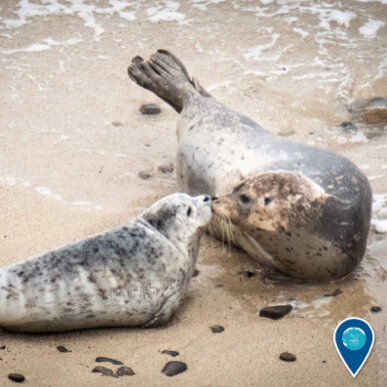Ooooh . . . . Baby, Baby
By Mary Jane Schramm
It was a bright spring day, the quiet of the harbor seal rookery broken only by an occasional squabble among gulls that often heralded a birth. The seal felt her near-term pup stir inside her: a familiar sensation, one she experienced annually since reaching sexual maturity, and one she would experience yearly, throughout her life. With birth still a week or so away, she was already restless and snappish, warning other seals away. The four to six weeks in which she would nurse, nuzzle, protect, and teach her pup to fish would be a one-on-one undertaking. Periodically, she would leave her pup alone on shore so she could forage, and continue to produce the thick, fat-rich milk that would produce a plump, independent pup that she might never see again.
By contrast, calving among sperm whales can be an intensively communal, long-term process. See this footage documenting the birth of three calves in one day, each attended by a large group of whales: https://www.youtube.com/watch?v=J0Ql4M7_pTY. These calves will be nursed by their mothers for up to two years, “nannied” by other females to give Mom a rest, and receive instruction from their elders on fishing and proper sperm whale social etiquette. Sadly, the newborn sperm whale calf that stranded on Southeast Farallon Island this past February may have been similarly welcomed into its too-brief life; perhaps even mourned. We can only wonder.
On Mother’s Day 2021, let’s celebrate some exceptional examples of marine “Mammas,” among them:
WISDOM: At over 70 years of age, Wisdom, a Laysan albatross from the Hawaiian archipelago, recently hatched a new chick in February 2021 at Midway Atoll. Biologists banded her in 1956. Though albatrosses normally mate for life, Wisdom has outlived two mates. Her current consort is Akeakamai, a much younger bird. Laysans forage thousands of miles to feed their chicks, even to waters off California.
GRANNY: Granny, a killer whale (Orcinus orca), who recently died at a possible age of 105 (this has been contested, but not resolved), was the grand matriarch of J-Pod, a Southern Resident killer whale clan of about 25 orcas. This represents the entire Southern Resident population of the Salish Sea, the waters of northwest Washington state and southern British Columbia. As the oldest female in her pod, she not only bore several offspring, but even after menopause assisted other cows in calf-rearing, an extended “motherhood” across generations.
THE ORIGINAL OCTO-MOMS: The Giant Pacific Octopus spends her entire life leading to a single breeding event. At age three to five, shortly after laying, tending to, and defending her one and only brood of up to 400,000 eggs, she will die, her precocious hatchlings jetting away to fulfil their separate destinies.
NON-BINARY “MOMS:” In a gender role reversal, it’s “hats off!” to our local seahorse, the snubnose pipefish whose males nurture eggs in their own brood pouches and give birth to live offspring. Likewise, to the Common murre Pops: once his still-dependent fledgling leaves the nest, it’s he who feeds it and teaches it to fish, giving Mom a well-earned postpartum recovery of her spent energy stores; it sure beats breakfast in bed one day a year!
This spring, experience the Moms and other marine wildlife of your marine sanctuary at https://farallones.noaa.gov/visit/. Remember: keep well away and concealed when visiting sensitive wildlife areas, observing posted guidelines; and leave pets at home. Appreciate how Mother Earth is really Mother Ocean, for ours is a blue planet of water, the amniotic soup from which life as we know it likely originated.
TOP: Harbor seal cow and pup remain apart from other seals on rookery. Photo: EIB-NOAA. Center: Septuagenarian albatross mom “Wisdom” and chick. Photo: US FWS. Bottom: Giant Pacific octopus whose brood may number over 400,000 eggs. Photo: EIB-NOAA.









